Numerical Study on Hydrogen–Gasoline Dual-Fuel Spark Ignition Engine
Abstract
:1. Introduction
2. Modeling Methodology
2.1. Engine Model
2.2. Solution Point
2.3. Numerical Model Validation
3. Results and Discussion
3.1. Influences of Direct Injection of Hydrogen on Combustion
3.2. Influences of Hydrogen Direct Injection on Emissions
4. Conclusions
Author Contributions
Funding
Data Availability Statement
Conflicts of Interest
Abbreviations
| aTDC | After Top Dead Center |
| bTDC | Before Top Dead Center |
| CAD | Crank angle degree |
| DI | Direct injection |
| CO | Carbon monoxide |
| CO2 | Carbon dioxide |
| COV | Coefficient of variation |
| EVO | Exhaust valve open |
| EVC | Exhaust valve close |
| HES | Hydrogen energy share |
| HRR | Heat release rate |
| IMEP | Indicated mean effective pressure |
| IVO | Intake valve open |
| IVC | Intake valve close |
| ICE | Internal combustion engine |
| TKE | Turbulent kinetic energy |
| PFI | Port fuel injection |
| PM | Particle Matter |
| RI | Ringing intensity |
| SI | Spark Ignition |
| SOI | Start of injection |
| SOC | Start of combustion |
References
- Yu, S.-T.; Chang, S.-C.; Jorgenson, P.; Park, S.-J.; Lai, M.-C. Basic equations of chemically reactive flows for computational fluid dynamics. In Proceedings of the 36th AIAA Aerospace Sciences Meeting and Exhibit, Reno, NV, USA, 12–15 January 1998. [Google Scholar] [CrossRef]
- Andwari, A.M.; Pesiridis, A.; Esfahanian, V.; Said, M.F.M. Combustion and Emission Enhancement of a Spark Ignition Two-Stroke Cycle Engine Utilizing Internal and External Exhaust Gas Recirculation Approach at Low-Load Operation. Energies 2019, 12, 609. [Google Scholar] [CrossRef] [Green Version]
- Andwari, A.M.; Said, M.F.M.; Aziz, A.A.; Esfahanian, V.; Salavati-Zadeh, A.; Idris, M.A.; Perang, M.R.M.; Jamil, H.M. Design, Modeling and Simulation of a High-Pressure Gasoline Direct Injection (GDI) Pump for Small Engine Applications. J. Mech. Eng. 2018, 1, 107–120. [Google Scholar]
- Andwari, A.M.; Aziz, A.A.; Said, M.F.M.; Latiff, Z.A.; Ghanaati, A. Influence of Hot Burned Gas Utilization on The Exhaust Emission Characteristics of A Controlled Auto-Ignition Two-Stroke Cycle Engine. Int. J. Automot. Mech. Eng. 2015, 11, 2396–2404. [Google Scholar] [CrossRef]
- Tartakovsky, L.; Sheintuch, M. Fuel reforming in internal combustion engines. Prog. Energy Combust. Sci. 2018, 67, 88–114. [Google Scholar] [CrossRef]
- Kamil, M.; Rahman, M.M. Performance prediction of spark-ignition engine running on gasoline-hydrogen and methane-hydrogen blends. Appl. Energy 2015, 158, 556–567. [Google Scholar] [CrossRef]
- Yu, X.; Li, D.; Yang, S.; Sun, P.; Guo, Z.; Yang, H.; Li, Y.; Wang, T. ScienceDirect Effects of hydrogen direct injection on combustion and emission characteristics of a hydrogen/Acetone-Butanol-Ethanol dual-fuel spark ignition engine under lean-burn conditions. Int. J. Hydrogen Energy 2020, 45, 34193–34203. [Google Scholar] [CrossRef]
- Niu, R.; Yu, X.; Du, Y.; Xie, H.; Wu, H.; Sun, Y. Effect of hydrogen proportion on lean burn performance of a dual fuel SI engine using hydrogen direct-injection. Fuel 2016, 186, 792–799. [Google Scholar] [CrossRef]
- Ji, C.; Wang, S.; Zhang, B.; Liu, X. Emissions performance of a hybrid hydrogen–gasoline engine-powered passenger car under the New European Driving Cycle. Fuel 2013, 106, 873–875. [Google Scholar] [CrossRef]
- Saravanan, N.Ã.; Nagarajan, G. An experimental investigation of hydrogen-enriched air induction in a diesel engine system. Int. J. Hydrogen Energy 2008, 33, 1769–1775. [Google Scholar] [CrossRef]
- Soyhan, H.S.; Karabag, B. Emission characteristics of an hydrogen–CH4 fuelled spark ignition engine. Fuel 2015, 159, 298–307. [Google Scholar]
- Ceviz, M.A.; Sen, A.K. Engine performance, exhaust emissions, and cyclic variations in a lean-burn SI engine fueled by gasoline e hydrogen blends. Appl. Therm. Eng. 2012, 36, 314–324. [Google Scholar] [CrossRef]
- Yu, X.; Du, Y.; Sun, P.; Liu, L.; Wu, H.; Zuo, X. Effects of hydrogen direct injection strategy on characteristics of lean-burn hydrogen–gasoline engines. Fuel 2017, 208, 602–611. [Google Scholar] [CrossRef]
- Wang, S.; Ji, C. Cyclic variation in a hydrogen-enriched spark-ignition gasoline engine under various operating conditions. Int. J. Hydrogen Energy 2011, 37, 1112–1119. [Google Scholar] [CrossRef]
- Welch, A.; Mumford, D.; Munshi, S.; Holbery, J.; Boyer, B.; Younkins, M.; Jung, H. Challenges in Developing Hydrogen Direct Injection Technology for Internal Combustion Engines; SAE International: Warrendale, PA, USA, 2018. [Google Scholar] [CrossRef]
- Kahraman, E.; Ozcanh, S.C.; Ozerdem, B. An experimental study on performance and emission characteristics of a hydrogen fuelled spark ignition engine. Int. J. Hydrogen Energy 2007, 32, 2066–2072. [Google Scholar] [CrossRef] [Green Version]
- Verhelst, S.; Wallner, T. Hydrogen-fueled internal combustion engines. Prog. Energy Combust. Sci. 2009, 35, 490–527. [Google Scholar] [CrossRef] [Green Version]
- Ji, C.; Wang, S.; Zhang, B. Effect of spark timing on the performance of a hybrid hydrogen–gasoline engine at lean conditions. Int. J. Hydrogen Energy 2010, 35, 2203–2212. [Google Scholar] [CrossRef]
- Ji, C.; Wang, S. Experimental study on combustion and emissions performance of a hybrid hydrogen–gasoline engine at lean burn limits. Int. J. Hydrogen Energy 2010, 35, 1453–1462. [Google Scholar] [CrossRef]
- Ji, C.; Cong, X.; Wang, S.; Shi, L.; Su, T.; Wang, D. Performance of a hydrogen-blended gasoline direct injection engine under various second gasoline direct injection timings. Energy Convers. Manag. 2018, 171, 1704–1711. [Google Scholar] [CrossRef]
- Hao, L.; Xu, X.; Guo, X.; Ji, C.; Wang, X.; Tan, J.; Ge, Y. Investigation of cold-start emission control strategy for a bi-fuel hydrogen/gasoline engine. Int. J. Hydrogen Energy 2016, 41, 18273–18281. [Google Scholar] [CrossRef]
- Wang, S.; Ji, C.; Zhang, M.; Zhang, B. Reducing the idle speed of a spark-ignited gasoline engine with hydrogen addition. Int. J. Hydrogen Energy 2010, 35, 10580–10588. [Google Scholar] [CrossRef]
- Ji, C.; Wang, S.; Zhang, B. Combustion and emissions characteristics of a hybrid hydrogen e gasoline engine under various loads and lean conditions. Int. J. Hydrogen Energy 2010, 35, 5714–5722. [Google Scholar] [CrossRef]
- He, F.; Li, S.; Yu, X.; Du, Y.; Zuo, X. Comparison study and synthetic evaluation of combined injection in a spark ignition engine with hydrogen-blended at lean burn condition. Energy 2018, 157, 1053–1062. [Google Scholar] [CrossRef]
- Al-Baghdadi, M.A.-R.S. A study on the hydrogen-ethyl alcohol dual fuel spark ignition engine. Energy Convers. Manag. 2002, 43, 199–204. [Google Scholar] [CrossRef]
- Ji, C.; Shi, C.; Wang, S.; Yang, J.; Su, T.; Wang, D. Effect of dual-spark plug arrangements on ignition Effect of dual-spark plug arrangements on ignition and combustion processes of a gasoline rotary engine with hydrogen direct-injection enrichment. Energy Convers Manag. 2018, 181, 372–381. [Google Scholar] [CrossRef]
- Wu, H.; Yu, X.; Du, Y.; Ji, X.; Niu, R.; Sun, Y.; Gu, J. Study on cold start characteristics of dual fuel SI engine with hydrogen direct-injection. Appl. Therm. Eng. 2016, 100, 829–839. [Google Scholar] [CrossRef]
- Li, G.; Yu, X.; Jin, Z.; Shang, Z.; Li, D.; Li, Y.; Zhao, Z. Study on effects of split injection proportion on hydrogen mixture distribution, combustion and emissions of a gasoline/hydrogen SI engine with split hydrogen direct injection under lean burn condition. Fuel 2020, 270, 117488. [Google Scholar] [CrossRef]
- Li, G.; Yu, X.; Shi, W.; Yao, C.; Wang, S.; Shen, Q. Effects of split injection proportion and the second injection timings on the combustion and emissions of a dual fuel SI engine with split hydrogen direct injection. Int. J. Hydrog. Energy 2019, 44, 11194–11204. [Google Scholar] [CrossRef]
- Du, Y.; Yu, X.; Liu, L.; Li, R. Effect of addition of hydrogen and exhaust gas recirculation on characteristics of hydrogen gasoline engine. Int. J. Hydrogen Energy 2017, 42, 8288–8298. [Google Scholar] [CrossRef]
- Sun, Y.; Yu, X.; Jiang, L. Effects of direct hydrogen injection on particle number emissions from a lean burn gasoline engine. Int. J. Hydrogen Energy 2016, 41, 18631–18640. [Google Scholar] [CrossRef]
- Du, Y.; Yu, X.; Wang, J.; Wu, H. Research on combustion and emission characteristics of a lean burn gasoline engine with hydrogen direct-injection. Int. J. Hydrogen Energy 2015, 41, 3240–3248. [Google Scholar] [CrossRef]
- Yu, X.; Wu, H.; Du, Y.; Tang, Y.; Liu, L.; Niu, R. Research on cycle-by-cycle variations of an SI engine with hydrogen direct injection under lean burn conditions. Appl. Therm. Eng. 2016, 109, 569–581. [Google Scholar] [CrossRef]
- Sun, Y.; Yu, X.; Dong, W.; Tang, Y. Effects of hydrogen direct injection on engine stability and optimization of control parameters for a combined injection engine. Int. J. Hydrogen Energy 2018, 43, 6723–6733. [Google Scholar] [CrossRef]
- Shi, W.; Yu, X.; Zhang, H.; Li, H. Effect of spark timing on combustion and emissions of a hydrogen direct injection stratified gasoline engine. Int. J. Hydrogen Energy 2017, 42, 5619–5626. [Google Scholar] [CrossRef]
- Pamminger, M.; Sevik, J.; Wooldridge, S.; Boyer, B. Performance, efficiency and emissions evaluation of gasoline port-fuel injection, natural gas direct injection and blended operation. In Proceedings of the ASME 2016 Internal Combustion Engine Division Fall Technical Conference, Greenville, SC, USA, 9–12 October 2016. ICEF2016-9370. [Google Scholar] [CrossRef]
- Liu, Y.-D.; Jia, M.; Xie, M.-Z.; Pang, B. Enhancement on a skeletal kinetic model for primary reference fuel oxidation by using a semidecoupling methodology. Energy Fuels 2012, 26, 7069–7083. [Google Scholar] [CrossRef]
- Aghahasani, M.; Gharehghani, A.; Andwari, A.M.; Mikulski, M.; Könnö, J. Effect of natural gas direct injection (NGDI) on the performance and knock behavior of an SI engine. Energy Convers Manag. 2022, 269, 116145. [Google Scholar] [CrossRef]
- Han, W.; Dai, P.; Gou, X.; Chen, Z. A review of laminar flame speeds of hydrogen and syngas measured from propagating spherical flames. Appl. Energy Combust. Sci. 2020, 1–4, 100008. [Google Scholar] [CrossRef]
- Huang, Z.; Zhang, Y.; Zeng, K.; Liu, B.; Wang, Q. Measurements of laminar burning velocities for natural gas–hydrogen–air mixtures. Combust. Flame 2006, 146, 302–311. [Google Scholar] [CrossRef]
- Tse, S.D.; Zhu, D.L.; Law, C.K. Morphology and burning rates of expanding spherical flames in h2/o2/inert mixtures up to 60 atmospheres. Proc. Combust. Inst. 2000, 28, 1793–1800. [Google Scholar] [CrossRef] [Green Version]
- Lamoureux, N.; Djeba, N.; Paillard, C. Laminar flame velocity determination for H2–air–He–CO2 mixtures using the spherical bomb method. Exp. Therm. Fluid Sci. 2003, 27, 385–393. [Google Scholar] [CrossRef]
- Gharehghani, A.; Ghasemi, K.; Siavashi, M.; Mehranfar, S. Applications of porous materials in combustion systems: A comprehensive and state-of-the-art review. Fuel 2021, 304, 121411. [Google Scholar] [CrossRef]
- Kakoee, A.; Gharehghani, A.; Mostafaei, M. Development of a reduced chemical kinetic mechanism for biodiesel/natural gas mixture. Fuel 2022, 312, 122920. [Google Scholar] [CrossRef]
- Moradi, J.; Gharehghani, A.; Aghahasani, M. Application of machine learning to optimize the combustion characteristics of RCCI engine over wide load range. Fuel 2022, 324, 124494. [Google Scholar] [CrossRef]
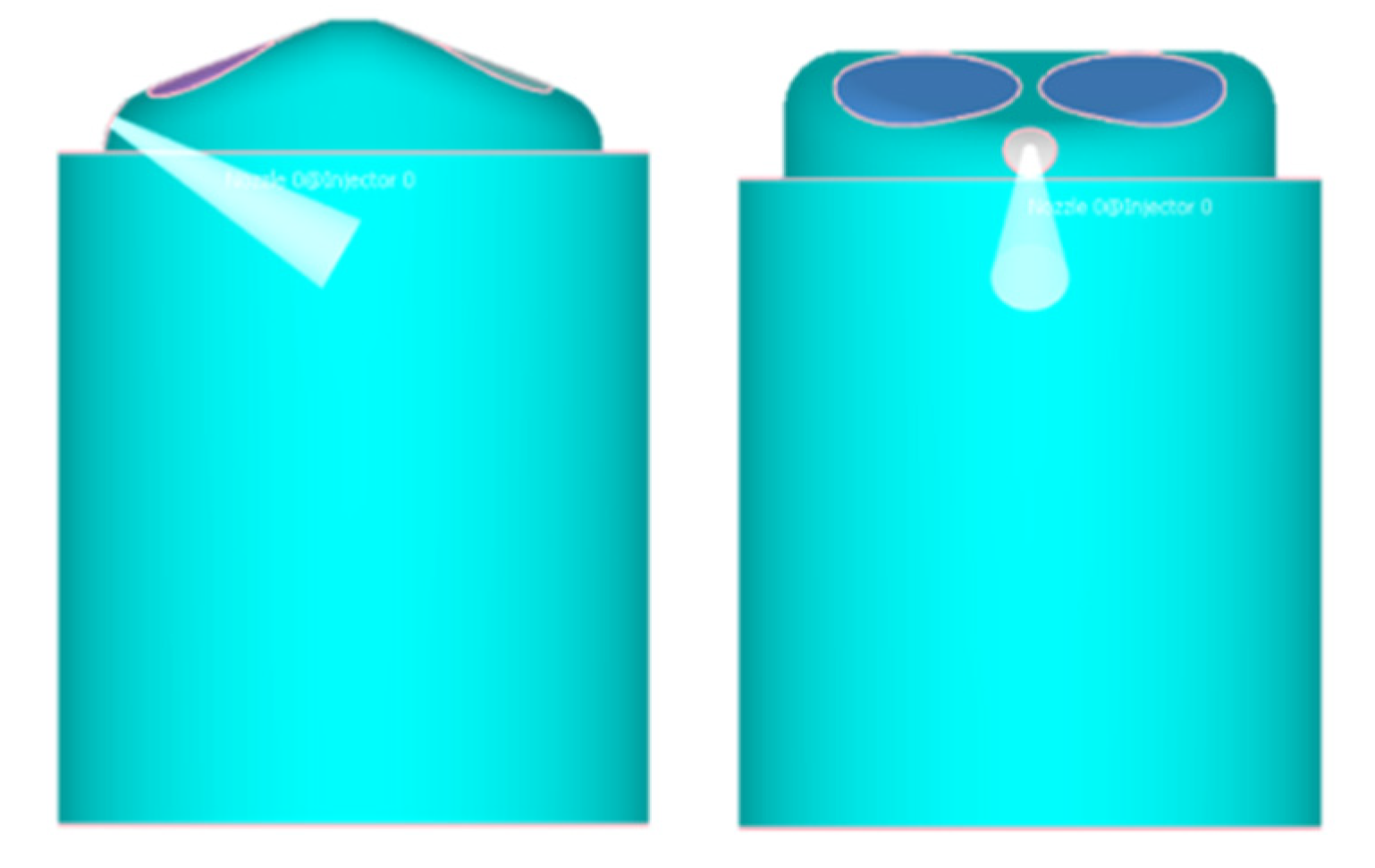
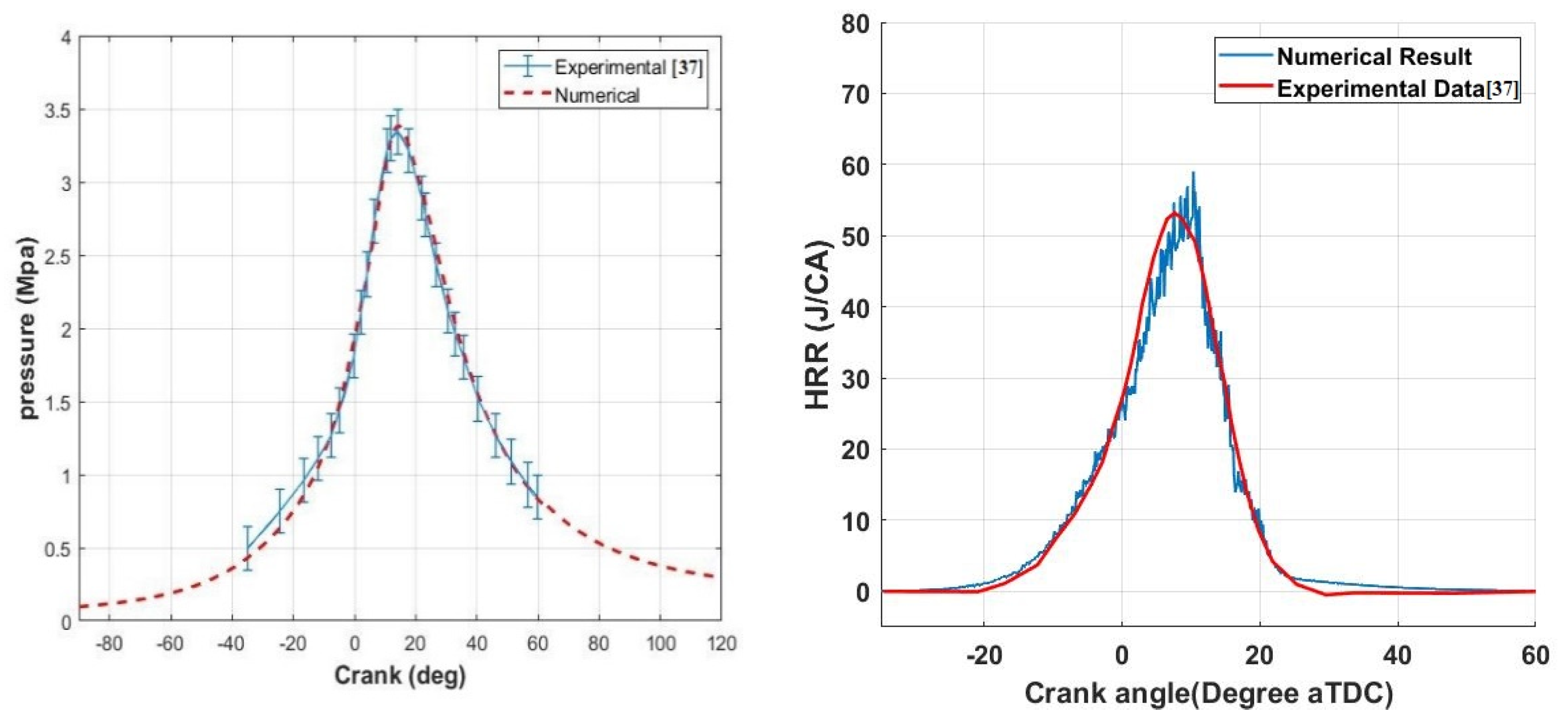
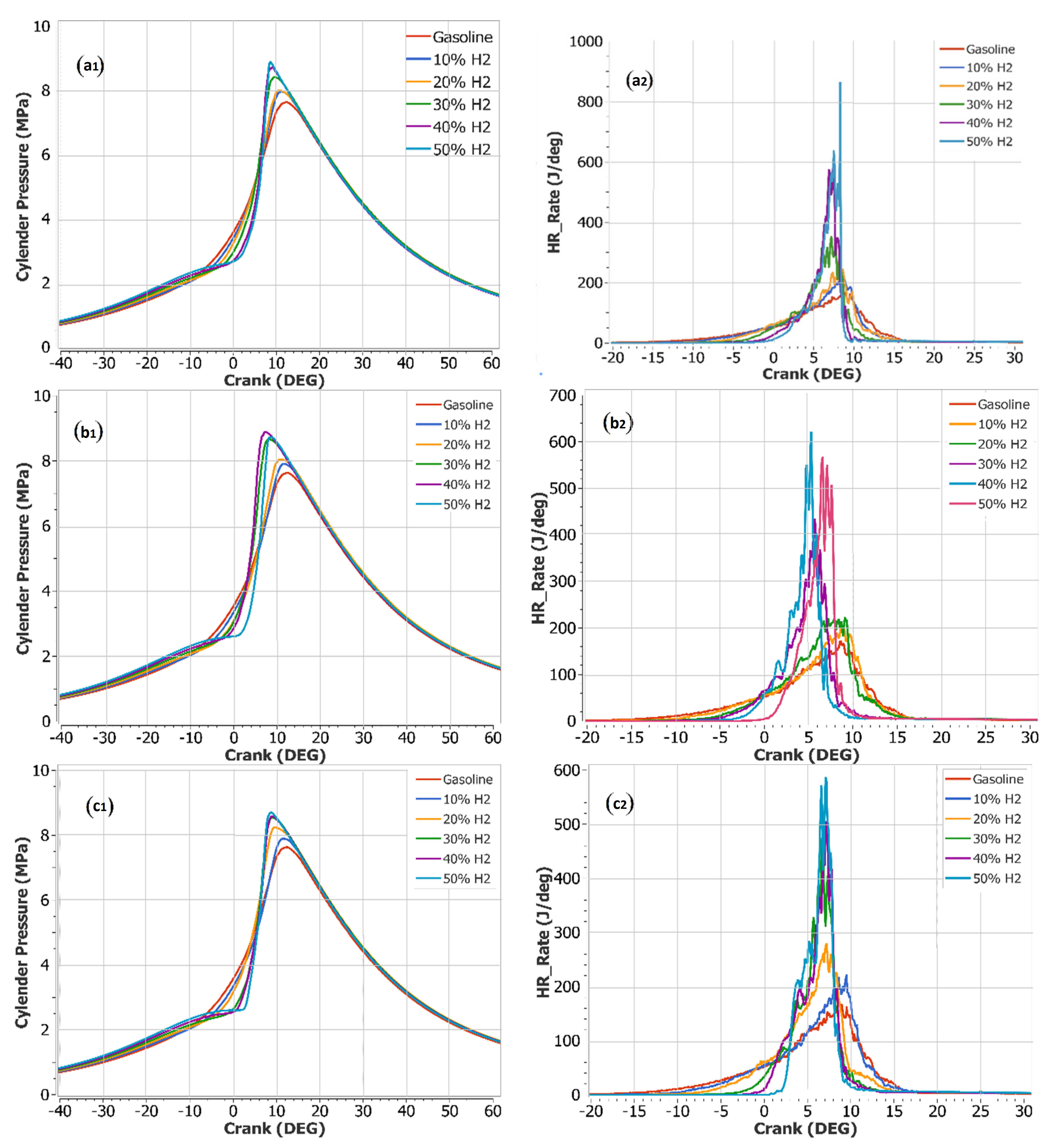
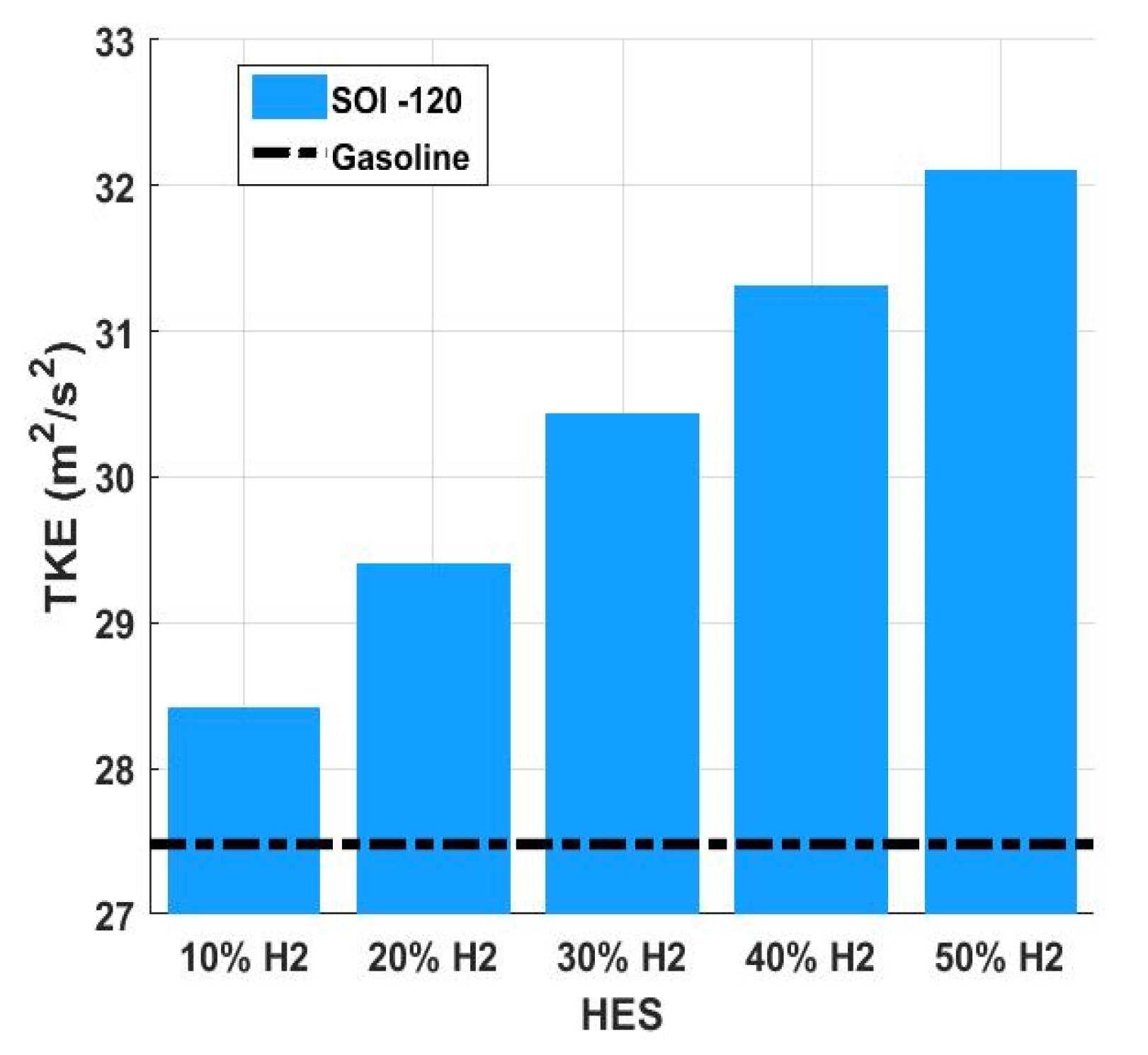
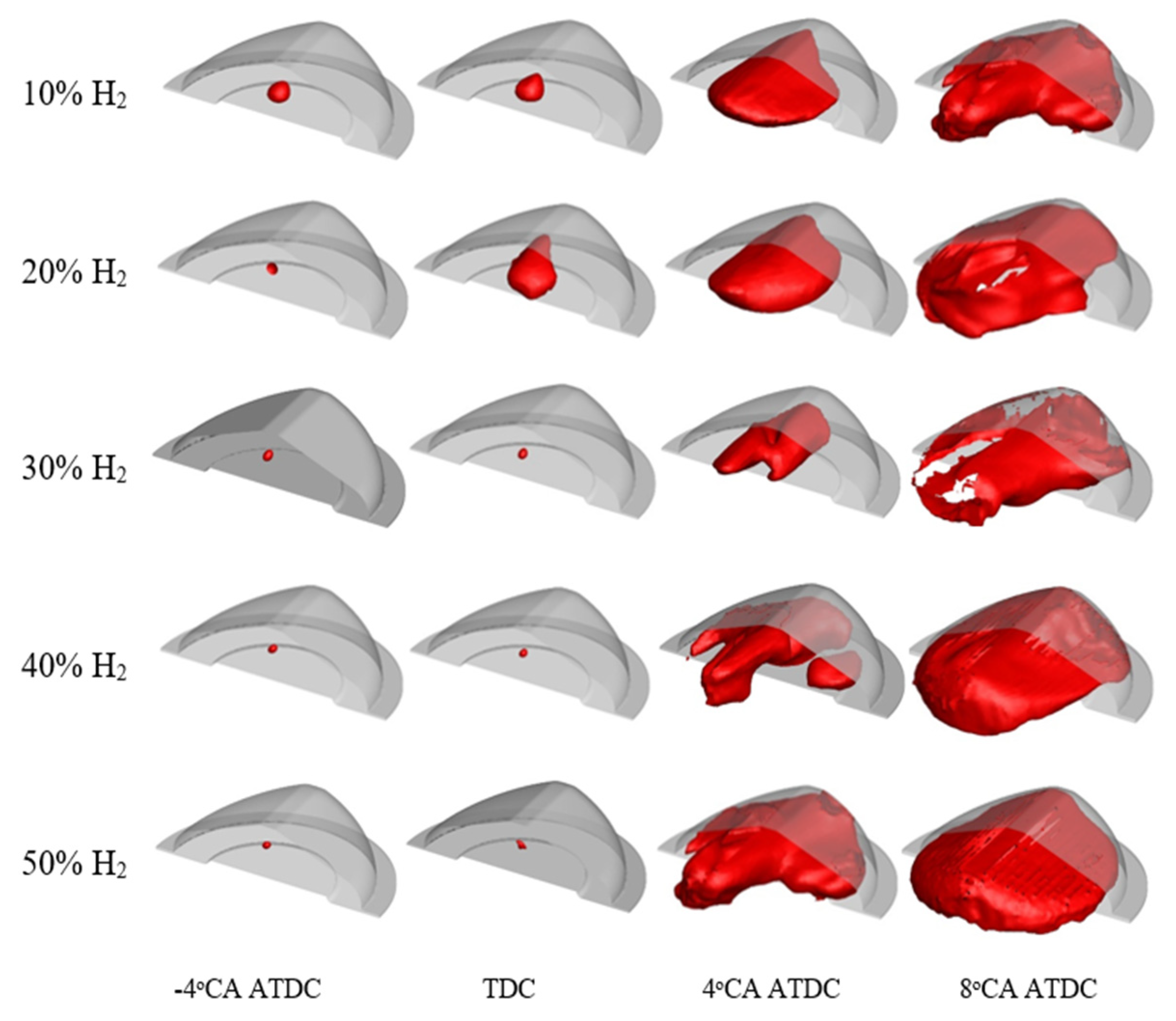
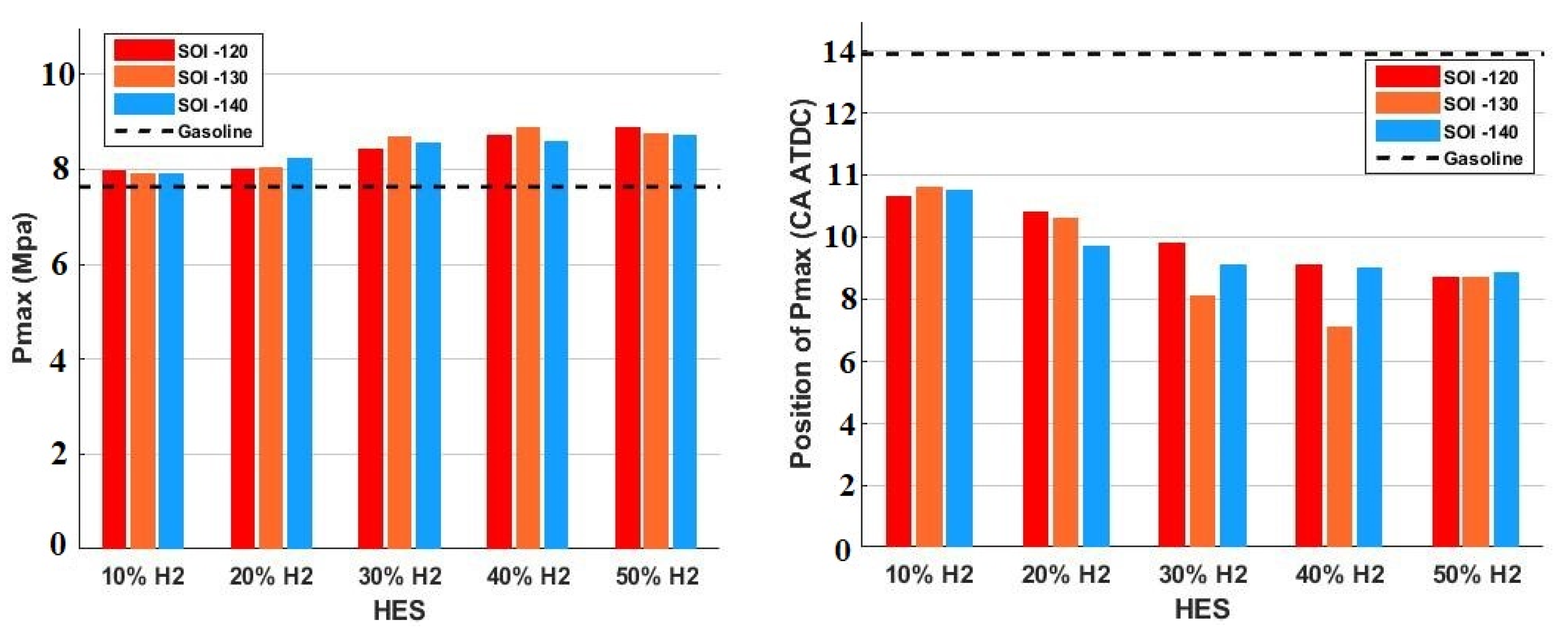

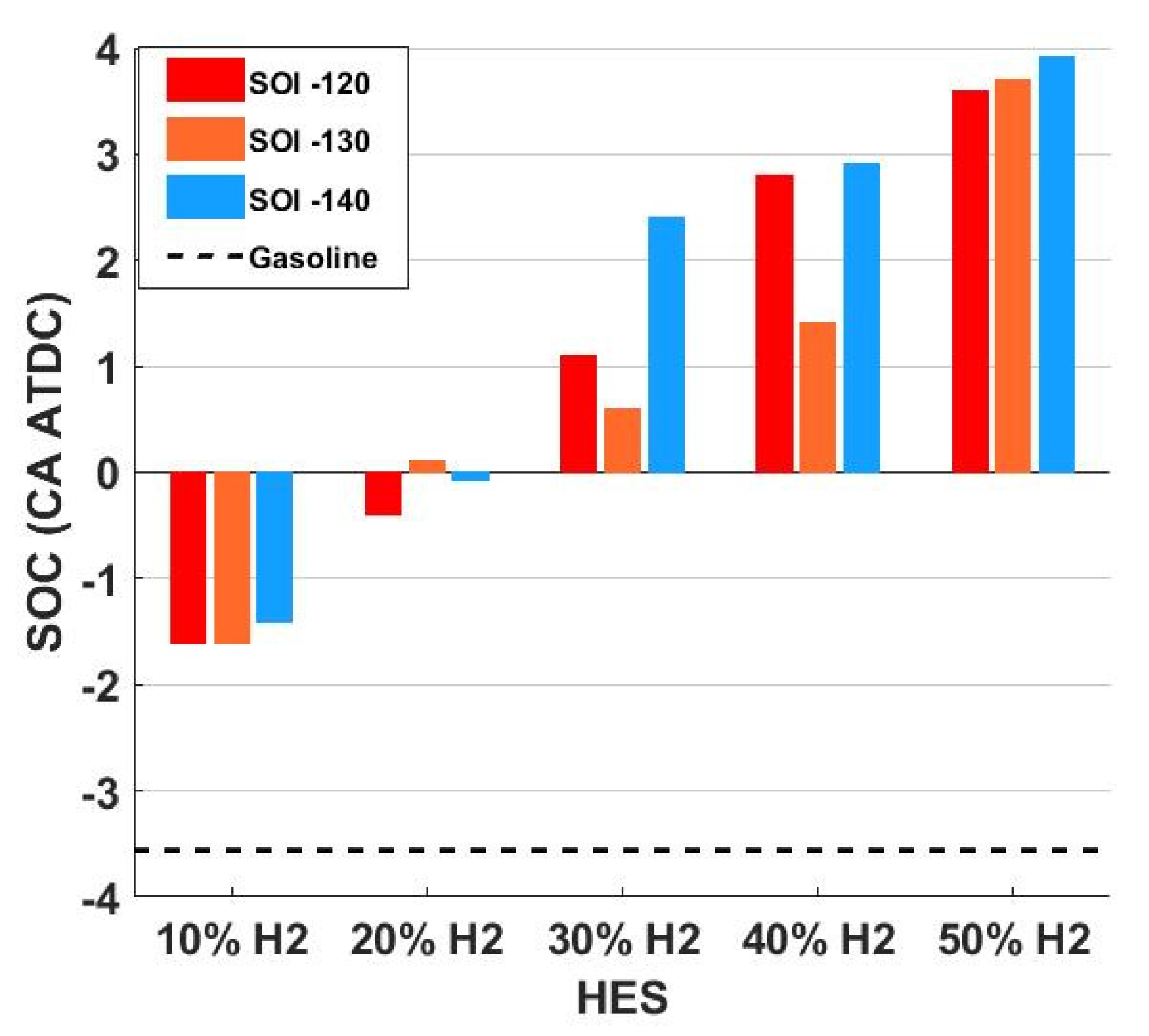


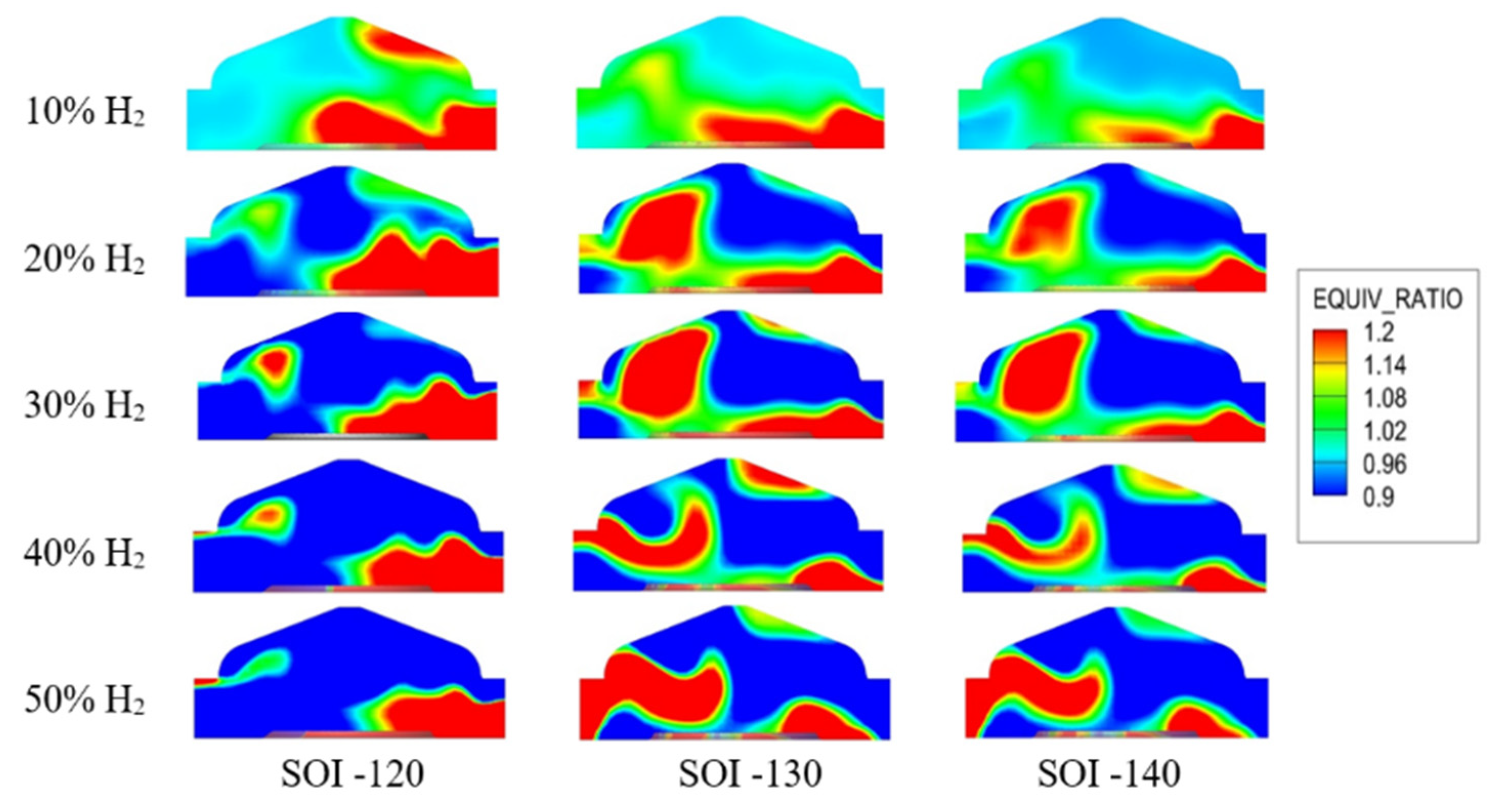
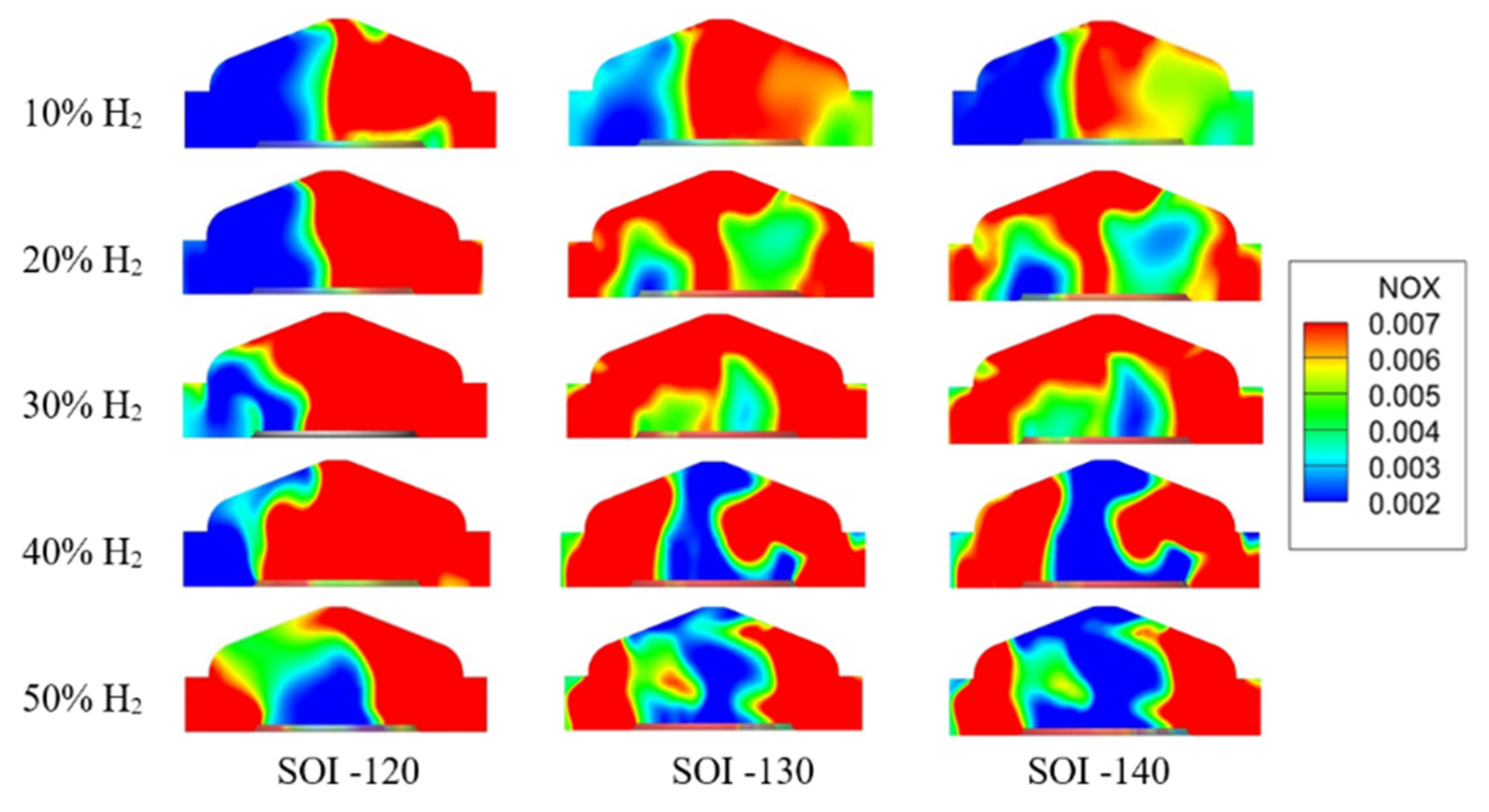

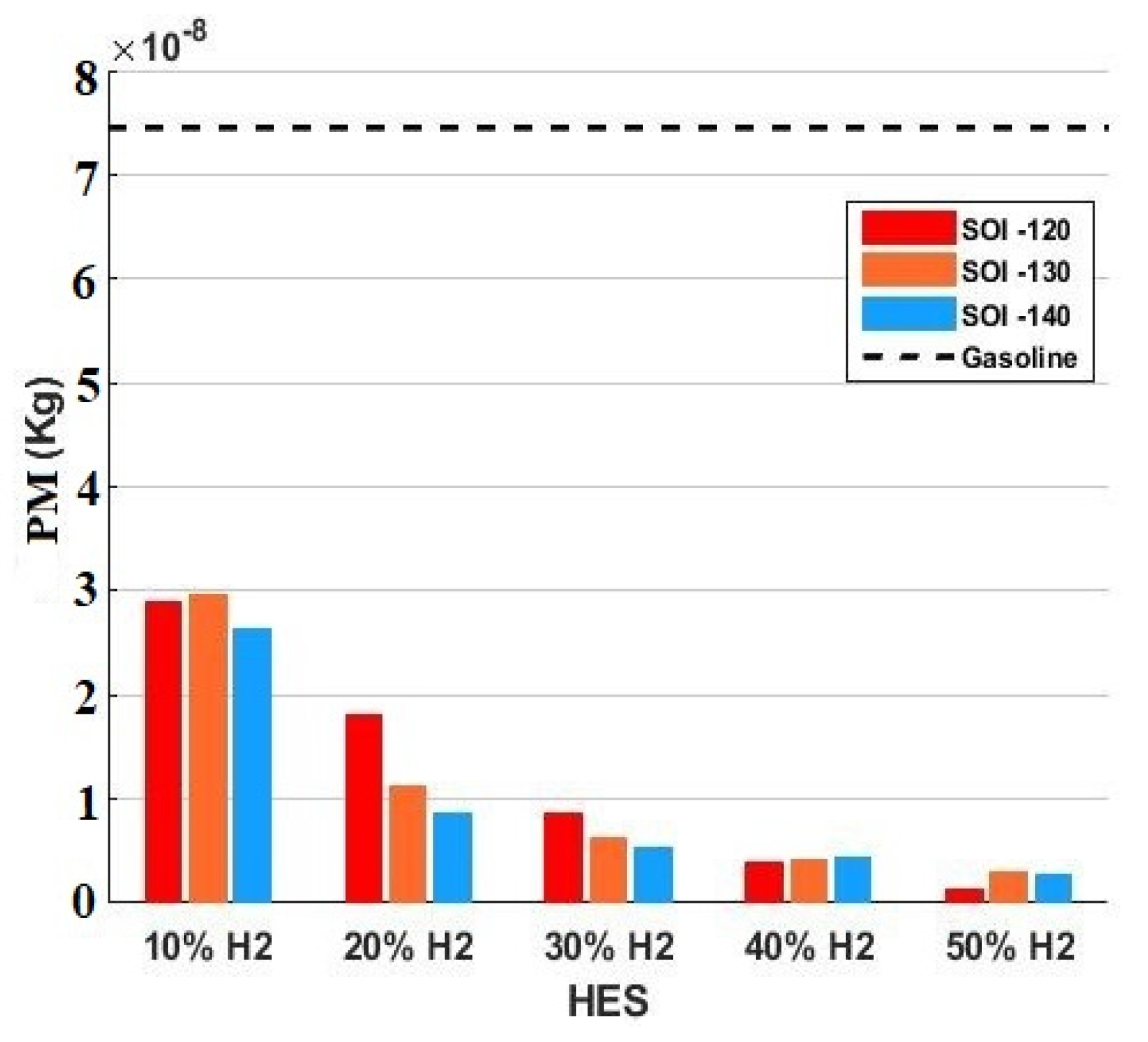
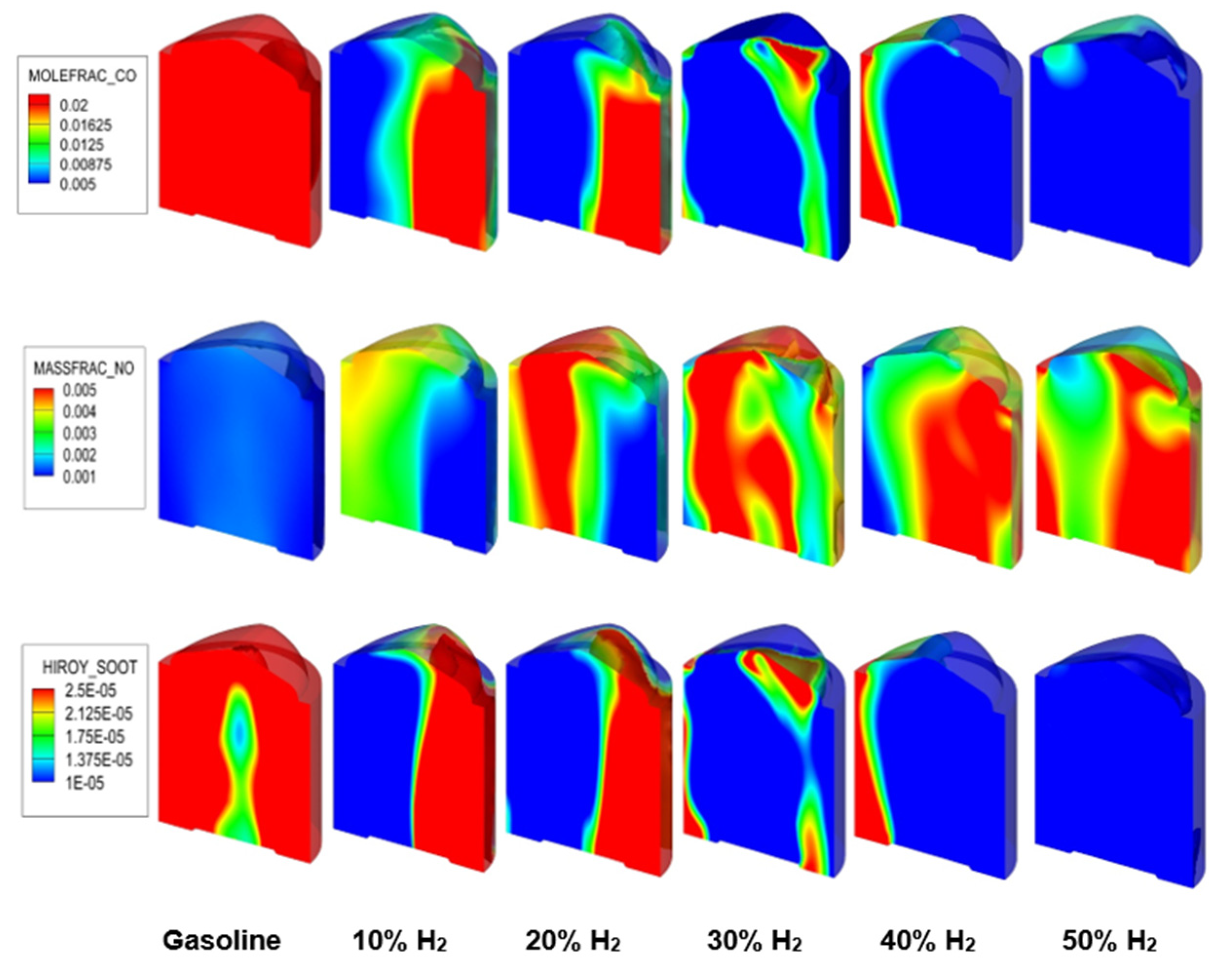
| Fuel Properties | Hydrogen (H2) | Gasoline |
|---|---|---|
| Diffusion coefficient (cm2/s) | 0.61 | 0.16 |
| Lower heating value (MJ/kg) | 120 | 44 |
| Laminar burning velocity (cm/s) (298 K, excess air ratio = 1, 0.1 MPa | 207 | 41.5 |
| Flammability limit (excess air ratio) | 0.14–10.08 | 0.6–2.4 |
| Adiabatic flame temperature (K) (Excess air ratio = 1) | 2318 | 2148 |
| Parameters | Specification |
|---|---|
| Displacement (cm3) | 626.4 |
| Stroke (mm) | 100.6 |
| Bore (mm) | 89.04 |
| Compression Ratio (Geometric) | 10.5:1 |
| Number of Intake and Exhaust Valve | 2/2 |
| EVO/EVC (CAD aTDC fired) | 150/−350 |
| IVO/IVC (CAD aTDC fired) | 350/−140 |
| Model of Parameters | Characteristics |
|---|---|
| Turbulence | RNG k-Model |
| Wall heat transfer | O’Rourke and Amsden Model |
| Combustion | SAGE |
| Ignition | Spark-energy Deposition Model |
| Parameter | Characteristics |
|---|---|
| Engine speed | 1500 rpm |
| Equivalence ratio | 1.0 |
| Gasoline (E10) LHV(MJ/kg) | 42.02 |
| Hydrogen (H2) LHV(MJ/kg) | 120 |
| Inlet pressure | 1.06 bar |
| Apparatus | Production Type |
|---|---|
| Ignition timing | Motec M800 |
| Injection timing (SOI) | Motec M800 |
| Throttling Regulators | Parker Pilot |
| Fuel flow meter | Coriolis fuel meter CMF010 |
| Crank angle position encoder | AVL 365X |
| In-cylinder pressure transducer | AVL GU21C |
Publisher’s Note: MDPI stays neutral with regard to jurisdictional claims in published maps and institutional affiliations. |
© 2022 by the authors. Licensee MDPI, Basel, Switzerland. This article is an open access article distributed under the terms and conditions of the Creative Commons Attribution (CC BY) license (https://creativecommons.org/licenses/by/4.0/).
Share and Cite
Aghahasani, M.; Gharehghani, A.; Mahmoudzadeh Andwari, A.; Mikulski, M.; Pesyridis, A.; Megaritis, T.; Könnö, J. Numerical Study on Hydrogen–Gasoline Dual-Fuel Spark Ignition Engine. Processes 2022, 10, 2249. https://doi.org/10.3390/pr10112249
Aghahasani M, Gharehghani A, Mahmoudzadeh Andwari A, Mikulski M, Pesyridis A, Megaritis T, Könnö J. Numerical Study on Hydrogen–Gasoline Dual-Fuel Spark Ignition Engine. Processes. 2022; 10(11):2249. https://doi.org/10.3390/pr10112249
Chicago/Turabian StyleAghahasani, Mahdi, Ayat Gharehghani, Amin Mahmoudzadeh Andwari, Maciej Mikulski, Apostolos Pesyridis, Thanos Megaritis, and Juho Könnö. 2022. "Numerical Study on Hydrogen–Gasoline Dual-Fuel Spark Ignition Engine" Processes 10, no. 11: 2249. https://doi.org/10.3390/pr10112249









